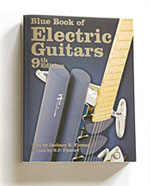Blue Book of Electric Guitars 9th Edition |
I know what you're thinking, and it's wrong. The unusual instrument on the 9th edition cover is not a leftover prop from a musical scene in "Star Wars, " it's not a do-it-yourself kit guitar gone wrong, nor is it a rare vintage model from a '60s Erector set. And yes, it's also not supposed to have a conventional body. So how does the cover guitar, a Teuffel Guitars Birdfish, actually work, and how could anyone euer come up with such an unusual design? The answer to the first question is somewhat complex, but if you know Ulrich Teuffel from New Ulm, Germany, the second answer is easy. Teuffel explains his theory on guitars in his own inimitable manner and dialogue:
Despite their simple construction, guitars are subject to special acoustic and electro-acoustic rules. The fundamental character of the sound is formed by the resonant properties of the body wood. Underneath the strings are the pickups, which, according to their position between the bridge and the neck, torwert string movements to electrical Signals comprised of various frequencies and harmonics. The composition of the pickups is made out of tappen wire and magnets and is tonally significant. These three fundamental principles form the character of the instrument. If one were to make them variable, then one could thereby change the character of the instrument. This is the theme of the Birdfish. The body, as a source of tone, is reduced to two cylindrical resonators, which are available in different materials, including swamp ash and maple. They are easily interchangeable by means of a screw connection. The resonators define the fundamental sound. They are easily exchangeable. Two blue resonators made of swamp ash are supplied, which are very responsive, yielding clean lows and highs. Two red maple resonators are also included in the set. They sound more powerful and forceful. The two aluminum sculptures, "bird" and "fish," assume the connection of all the components. They are bridges of vibration-transfer, and establish contact to the body of the player. The bird piece (attached to neck) is one of the two central elements that connect the components. This part's tonal function is crucial. It requires an extraordinarüy careful manufacture. The fish piece is the second of the two central elements that connect components, including the bridge and electronics box. For this element, a particularly neutral-sounding aluminum alloy is used. The casting process for this fish element occurs in a vacuum. Afterwards, the sculpture is hand-polished to a high gloss and chromeplated. The adjustable pickups are arranged on a rail with linear markings and therefore pick up the overtones variably. Additionally, five pickups with different characteristics are at one's disposal. One can very easily go through all the variations, since these pickups are shiftable and twistable. In addition, they can be easily exchanged by means of a screw connection. That way, the strings can remain in their tuning. Two single coils and three humbuckers are included. They can be adjusted into any position. Naturally, all the pickups are hand-wound with great care. The neck has a 25-1/2 inch scale length (650 mm). Like the fingerboard, it is made of bird's-eye maple. The neck is connected to the bird element with a metrical screw connection. The frets are narrow and tall. The string clamp serves as the string attachment to the neck. You can use regular strings, without double-ball ends. The strings are easily secured with the Small levers. Headless hardware, with which you tune the guitar. The strings are easily installed by the ball-ends. The instrument is tuned by turning the tuning knobs. Normal strings can be used. The electronics box pod is adjustable, in Order for the fade-in control to conform to your playing position. The five-way selector corresponds to that of a Stratocaster. An optional Midi version with RMC Piezo bridge and Poly-drive Controller is also available, and coupled with an interchangeable tune-o-matic bridge, enables the quick change into a Midi-Birdfish. Completing the Set is a heavily padded gig bag made out of the finest Nubuck leather, with four external pockets, which contains the two extra pickups and sound resonators. A shoulder strap is also included. Only five hundred of these instruments will be manufactured, and each one is individually hand serial numbered. Steve Fjestad |
|
||||

